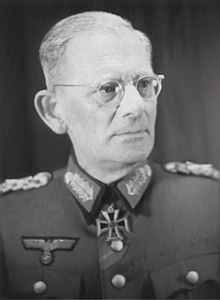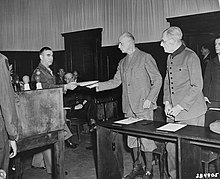Maximilian von Weichs
Maximilian von Weichs | |
|---|---|
 Weichs as Generalfeldmarschall c. 1943-45 | |
| Born | 12 November 1881 Dessau, German Empire |
| Died | 27 September 1954 (aged 72) Bonn, West Germany |
| Allegiance | |
| Service/ | |
| Years of service | 1900–45 |
| Rank | |
| Commands held | 1st Panzer Division XIII Corps 2nd Army Army Group B Army Group F OB Südost |
| Battles/wars | World War I
|
| Awards | Knight's Cross of the Iron Cross with Oak Leaves |
| Signature | |
Maximilian Maria Joseph Karl Gabriel Lamoral Reichsfreiherr[a] von und zu Weichs an der Glon (12 November 1881 – 27 September 1954) was a German Generalfeldmarschall (Field marshal) in the Wehrmacht of Nazi Germany during World War II.
Born into an aristocratic family, Weichs joined the Bavarian cavalry in 1900 and fought in the
In August 1942 during
Early life and career
World War I
Born in 1881 into an aristocratic family, Maximilian von Weichs entered the Bavarian cavalry in 1900 and participated in World War I as a staff officer. After the war he remained in the newly created Reichswehr where he worked at a number of General Staff positions.
Inter-war years

Transferred from the 3rd Cavalry Division to command Germany's 1st Panzer Division upon its formation in October 1935, he led the unit in maneuvers that impressed Army Commander-in-Chief Werner von Fritsch.[1] Weichs' aristocratic and cavalry credentials demonstrated the continuing influence of these military elites in Germany's modernizing force.[2] In October 1937, he became the commander of the XIII Army Corps that later served in the 1938 German annexation of the Sudetenland.
World War II
This section needs additional citations for verification. (May 2022) |

To prepare for the German invasion of Poland beginning World War II in 1939, Weichs was appointed head of his own Army Corps "Weichs". After the Polish surrender, he was made Commander-in-Chief of the

In 1942, for

The Soviet
Weichs was promoted to Generalfeldmarschall on 1 February 1943. In August 1943, Weichs was appointed commander of Army Group F in the Balkans directing operations against local partisan groups. From August 1943, Weichs was also OB Südost, commander-in-chief of German-occupied Greece and the Balkans (Yugoslavia, Albania and Thrace). His headquarters were first in Belgrade and, from 5 October 1944, in Vukovar.[4] In April 1944, Weichs was appointed the commander of all German troops in Hungary.[5] In late 1944, he oversaw the German retreat from Greece and most of Yugoslavia.
Post-war years

Weichs retired from his military career on 25 March 1945, and was arrested by American troops in May. During the
Weichs died on 27 September 1954 in Bonn, West Germany at the age of 72.[7]
Awards
- Iron Cross of 1914 2nd Class (20 September 1914) & 1st Class (12 November 1915)[8]
- Clasp to the Iron Cross of 1939 2nd Class (18 September 1939) & 1st Class (29 September 1939)[8]
- Knight's Cross of the Iron Cross with Oak Leaves
Promotions
- Fahnenjunker: 15 July 1900
- Leutnant: 12 March 1902
- Oberleutnant: 3 March 1911
- Hauptmann: 1914
- Major: 1 February 1921
- Oberstleutnant: 1 February 1928
- Oberst: 1 November 1930
- Generalmajor: 1 April 1933
- Generalleutnant: 1 April 1935
- General der Kavallerie: 1 October 1936
- Generaloberst: 19 July 1940
- Generalfeldmarschall: 1 February 1943
Notes
- title of nobility, usually translated as Baron of the Empire. Freiherr is a title usually translated as Baron, and Reich is usually translated as Empire. The female forms are Reichsfreifrau and Reichsfreiin. Titles using the prefix Reichs- were not created after the fall of the Holy Roman Empire.
References
Citations
- ^ Showalter 2009, p. 47.
- ^ Showalter 2009, p. 59.
- ISBN 9781473833869.
- ^ Brett-Smith 1977, p. 172"From August 1943 von Weichs, now a field-marshal, was C-in-C Yugoslavia, Albania, and Thrace, with headquarters first in Belgrade and — from 5 October 1944 — at Vukovar."
- ^ Wistrich 2002, p. 272.
- ^ "Subsequent Nuremberg Proceedings, Case #7, The Hostage Case". encyclopedia.ushmm.org. Retrieved 2023-09-24.
- ISSN 0362-4331. Retrieved 2023-09-24.
- ^ a b Thomas 1998, p. 422.
- ^ a b Scherzer 2007, p. 772.
Bibliography
- Goda, Norman (2005). "Black Marks: Hitler's Bribery of his Senior Officers During World War II". In Kreike, Emmanuel; Jordan, William Chester (eds.). Corrupt Histories. Toronto: Hushion House. pp. 96–137. S2CID 154044694.
- Hürter, Johannes (2006). Hitlers Heerführer - Die deutschen Oberbefehlshaber im Krieg gegen die Sowjetunion 1941/42 (in German). München, Germany : Oldenbourg: Oldenbourg. ISBN 978-3-486-57982-6.
- ISBN 0-7006-1015-4.
- Scherzer, Veit (2007). Die Ritterkreuzträger 1939–1945 Die Inhaber des Ritterkreuzes des Eisernen Kreuzes 1939 von Heer, Luftwaffe, Kriegsmarine, Waffen-SS, Volkssturm sowie mit Deutschland verbündeter Streitkräfte nach den Unterlagen des Bundesarchives [The Knight's Cross Bearers 1939–1945 The Holders of the Knight's Cross of the Iron Cross 1939 by Army, Air Force, Navy, Waffen-SS, Volkssturm and Allied Forces with Germany According to the Documents of the Federal Archives] (in German). Jena, Germany: Scherzers Militaer-Verlag. ISBN 978-3-938845-17-2.
- Showalter, Dennis E. (2009). Hitler's Panzers: The Lightning Attacks That Revolutionized Warfare. New York: Berkley. ISBN 978-0-425-23004-6.
- ISBN 978-1-107-08760-6.
- Thomas, Franz (1998). Die Eichenlaubträger 1939–1945 Band 2: L–Z [The Oak Leaves Bearers 1939–1945 Volume 2: L–Z] (in German). Osnabrück, Germany: Biblio-Verlag. ISBN 978-3-7648-2300-9.
- Wistrich, Robert S. (2002). Who's who in Nazi Germany. Psychology Press. ISBN 978-0-415-26038-1.
- Brett-Smith, Richard (1977). Hitler's generals. Presidio Press. ISBN 978-0-89141-044-7.
